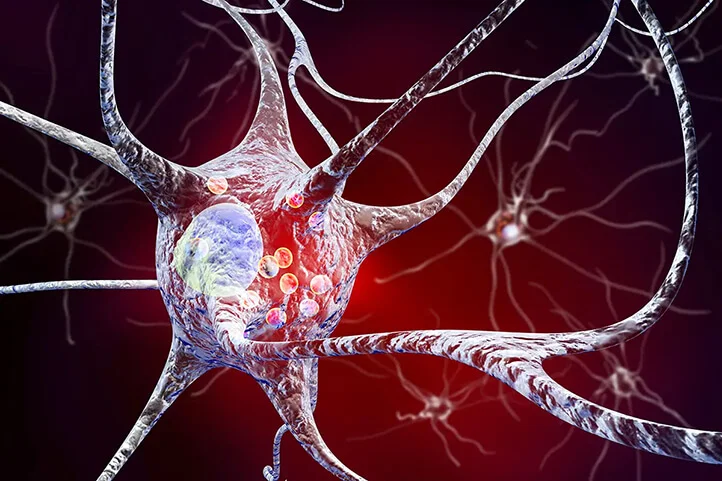Restless Legs Syndrome (RLS), also known as Willis-Ekbom disease, is a neurological disorder characterized by unpleasant sensations in the legs and an overwhelming urge to move. These symptoms typically worsen during periods of rest or inactivity, especially in the evening and at night, and can seriously disrupt sleep and quality of life.
RLS is considered a fairly common condition, affecting about 5-10% of the adult population in various countries around the world. However, the exact prevalence may be higher, as many people do not seek medical help, or their symptoms are not properly recognized.
Although restless legs syndrome can occur at any age, it most often develops in adults over the age of 40. However, there is also a childhood form of RLS, which may manifest at an early age. In children, the symptoms may differ slightly from those in adults, often involving constant tossing and turning, restlessness, and reluctance to stay in bed.

Symptoms of Restless Legs Syndrome
RLS can significantly impair the quality of life by disrupting sleep and causing constant discomfort. Therefore, it is crucial to recognize its symptoms at an early stage to begin treatment in a timely manner and prevent worsening of the condition.
Main Symptoms
The key symptoms of RLS include:
- Unpleasant sensations in the legs. People often describe these as burning, tingling, aching, pulling, or “creepy-crawly” sensations. These feelings can range from mild to very severe and distressing, sometimes spreading to the arms.
- An overwhelming urge to move. Unpleasant sensations cause an almost irresistible desire to move the legs, walk, or change body position to get temporary relief. These movements can take various forms, such as foot tapping, bending and straightening the feet, or pacing around the room.
When do symptoms worsen?
RLS symptoms tend to worsen in the following situations:
- During rest or inactivity. Unpleasant sensations and the urge to move usually occur or intensify when a person is sitting or lying still for an extended period. For example, while watching TV, reading, or during long trips.
- In the evening and at night. RLS symptoms are typically most pronounced in the evening and nighttime hours, which can seriously disrupt sleep and rest. Many people with RLS note that their symptoms worsen about an hour after going to bed.
- During periods of stress or emotional tension. Stress and anxiety can exacerbate RLS symptoms.
Impact on sleep and quality of life
Restless legs syndrome can have a significant negative impact on a person’s sleep and quality of life. Frequent restlessness and the need to move at night lead to sleep disturbances, causing people to suffer from:
- Chronic fatigue and sleep deprivation;
- Difficulty concentrating and remembering;
- Irritability, depression, and mood swings;
- Decreased work performance and productivity;
- Cognitive impairments and reduced quality of life.
Additionally, RLS can negatively affect a person’s social and family life, as their difficulties falling asleep or frequent night awakenings may disturb their partner.

Causes of Restless Legs Syndrome
Restless legs syndrome can be caused by various factors, including idiopathic cases, nutrient deficiencies, hereditary factors, and associations with other diseases and medications.
Idiopathic Cases
In some cases, the cause of RLS remains unknown. These cases are called idiopathic or primary. They may be related to genetic factors or dysfunction in certain neurotransmitters, such as dopamine and iron, in the brain.
It is believed that idiopathic RLS may be caused by dysfunction in certain areas of the brain responsible for regulating movement and sensory perception, such as the basal ganglia and spinal cord.
Association with iron deficiency and other disorders
Restless legs syndrome is often associated with iron deficiency, as well as with other metabolic disorders, such as:
- Anemia. A lack of iron in the body can lead to the development of anemia, which in turn increases the risk of RLS.
- Vitamin B12 or folic acid deficiency may also contribute to the development of restless legs syndrome.
- Kidney dysfunction. People with chronic kidney failure have an increased risk of developing RLS due to metabolic disturbances.
- Pregnancy. During pregnancy, the body’s need for iron increases, which can lead to its deficiency and the development of restless legs syndrome, especially in the third trimester.
Hereditary factor
RLS has a hereditary component. If one parent has this disorder, the risk of RLS in offspring increases significantly. Studies show that about 60% of RLS cases have a genetic predisposition.
Scientists have identified several genes associated with the risk of developing restless legs syndrome, including genes involved in iron transport and metabolism, as well as the dopamine system of the brain.
Association with diseases and medications
Restless legs syndrome can also be a secondary condition associated with diseases such as:
- Diabetes. People with diabetes have an increased risk of developing RLS due to peripheral nerve damage and metabolic disturbances related to the disease.
- Parkinson’s disease. RLS often develops in patients with Parkinson’s disease due to disruptions in the brain’s dopamine system.
- Peripheral neuropathy. Damage to peripheral nerves, such as diabetic or alcoholic neuropathy, can cause symptoms similar to restless legs syndrome.
- Kidney disease. Kidney failure and related metabolic disturbances increase the risk of developing RLS.
- Multiple sclerosis. Some patients with multiple sclerosis may experience symptoms similar to RLS due to central nervous system damage.
- Rheumatoid arthritis. This chronic autoimmune disease may also be associated with an increased risk of RLS.
In addition to specific diseases, restless legs syndrome can be linked to medications such as:
- Antidepressants such as selective serotonin reuptake inhibitors (SSRIs) and tricyclic antidepressants, which can cause or worsen RLS symptoms.
- Antihistamines, especially sedative ones, may trigger RLS symptoms.
- Antipsychotic medications, such as phenothiazines and butorphanol, are associated with an increased risk of RLS.
- Cancer medications. Certain chemotherapy drugs and treatments for cancer can cause symptoms similar to RLS.
It’s important to note that not everyone with these conditions or taking these medications will develop restless legs syndrome. However, these factors increase the risk of its occurrence.
Other potential causes of RLS include magnesium deficiency, obesity, smoking, and excessive alcohol consumption. However, the mechanisms underlying the connection between these factors and RLS are not yet fully understood.

Diagnosis of Restless Legs Syndrome
The diagnosis of RLS is primarily based on the clinical presentation and the patient’s history, as well as the exclusion of other potential causes of leg discomfort. The following approaches are used to diagnose restless legs syndrome:
History and patient interview
Diagnosis of RLS begins with a thorough interview and collection of the patient’s history, including:
- Description of symptoms. The patient describes in detail the unpleasant sensations in the legs, their nature, intensity, and location.
- Symptom duration. It is important to determine how long the patient has been experiencing these symptoms and how often they occur.
- Time of day. The doctor must find out at what time of day or night the symptoms are most pronounced.
- Factors that provoke or alleviate symptoms. The patient is asked about situations in which symptoms worsen or ease, such as during rest, movement, or sleep.
- Presence of other associated diseases or conditions. The doctor must obtain information about any coexisting conditions, such as diabetes, kidney disease, or neurological disorders, that may be associated with RLS.
- Medications. It is necessary to find out if the patient is taking any medications that could cause or worsen RLS symptoms.
- Family history. The presence of RLS in relatives may indicate a genetic predisposition.
Exclusion of other possible causes
After collecting the patient’s history, the doctor must rule out other possible causes that may produce similar symptoms, such as:
- Peripheral neuropathy. Damage to peripheral nerves can cause sensations similar to RLS.
- RLS in association with diseases. Some neurological conditions, such as Parkinson’s disease, multiple sclerosis, or radiculopathy, may be accompanied by symptoms resembling RLS.
- Venous insufficiency. Problems with venous blood circulation in the legs can also cause discomfort.
- Arthritis and other musculoskeletal disorders. Inflammatory and degenerative diseases of the joints and bones can be the source of leg pain.
Additional studies
In some cases, additional studies may be needed to confirm the diagnosis of restless legs syndrome and rule out other possible causes, such as:
- Blood tests are conducted to identify iron deficiency, vitamin B12, folic acid, and other metabolic disorders associated with RLS.
- Electromyography (EMG) is used to assess peripheral nerve function and rule out peripheral neuropathy.
- Polysomnography (sleep study) helps to identify sleep disturbances associated with RLS and rule out other sleep disorders, such as sleep apnea.
- Magnetic resonance imaging (MRI) of the brain and spinal cord is used to rule out structural lesions that may mimic RLS symptoms.
- Electroencephalography (EEG) is used to assess brain bioelectrical activity and rule out epilepsy or other neurological disorders that may present with similar symptoms.
After conducting the necessary studies and ruling out other possible causes, the doctor can diagnose “restless legs syndrome” based on the patient’s characteristic symptoms and history.
It is important to note that diagnosing RLS can be challenging because symptoms may vary in severity and presentation from person to person. Additionally, RLS is often accompanied by other sleep disorders, which must also be considered when making a diagnosis.

Treatment of Restless Legs Syndrome
Treatment for restless legs syndrome (RLS) typically involves a combination of non-drug and drug therapies, as well as eliminating potential triggers. The treatment approach is determined by the severity of symptoms, their impact on quality of life, and the presence of comorbidities.
Non-Drug Therapies
In cases of mild or moderate RLS symptoms, and in the absence of contraindications, it is recommended to start with non-drug treatments:
- Physical exercise. Regular physical activity, such as walking, swimming, or cycling, helps alleviate RLS symptoms and improve overall well-being.
- Leg massage. Gentle leg massages may temporarily reduce unpleasant sensations and relax muscles.
- Warm baths and heat application. Warm foot baths or the use of heating pads or warming creams for the legs can provide relief by improving circulation and relaxing muscles.
- Relaxation techniques. Methods such as box breathing, meditation before bed, yoga, and progressive muscle relaxation help reduce stress and anxiety, which may exacerbate RLS symptoms.
- Regular stretching exercises. Stretching leg muscles before bed helps relieve discomfort and improve sleep quality.
- Limiting caffeine and alcohol intake. These substances may worsen RLS symptoms, so their limitation or complete avoidance is recommended.
Non-drug methods are particularly useful in the early stages of restless legs syndrome or as an adjunct to drug therapy. However, in severe or persistent symptoms, drug treatment may be required.
Drug Therapy
If non-drug methods are insufficient or if RLS symptoms are severe and significantly impair quality of life, a doctor may prescribe medications, including:
- Iron supplements. If iron deficiency is detected, iron supplements are prescribed to restore iron levels in the body. This can significantly alleviate RLS symptoms in many patients.
- B vitamins. If a deficiency in vitamin B12 or folic acid is identified, appropriate vitamin supplements may be prescribed.
- Dopaminergic agonists. These drugs, such as pramipexole, ropinirole, rotigotine, and others, are most effective for treating RLS. They affect the dopaminergic system in the brain, which plays an important role in regulating movement. Dopaminergic agonists are considered the first-line therapy for moderate to severe restless legs syndrome.
- Alpha-2-delta ligand drugs. Gabapentin, pregabalin, and others may be used as an alternative or adjunct to dopaminergic agonists. They have anticonvulsant and analgesic effects and may be effective in treating RLS, particularly in patients with neuropathic pain or when dopaminergic agonists are contraindicated.
- Benzodiazepines. Drugs like clonazepam may be prescribed for short-term symptom relief, but due to the risk of dependence and addiction, they are not recommended for long-term use.
- Opioid analgesics. In rare cases, for very severe and refractory forms of RLS that do not respond to other treatments, mild opioid analgesics, such as codeine or tramadol, may be prescribed. However, their use should be strictly controlled due to the risk of addiction.
It is important to remember that drug treatment should be supervised by a doctor, as some medications may have side effects and interactions with other drugs. Dosages and treatment duration are determined individually for each patient.
Eliminating Triggering Factors
In addition to non-drug and drug treatments, it is recommended to eliminate factors that may provoke or worsen restless legs syndrome symptoms:
- Avoid prolonged periods of immobility or inactivity, and take frequent breaks for movement.
- Maintain a healthy sleep routine and practice proper sleep hygiene.
- Limit the intake of caffeine, alcohol, nicotine, and other substances that may worsen symptoms.
- Maintain a healthy weight and regular physical activity.
- Ensure proper treatment and control of comorbidities, such as diabetes, kidney failure, or peripheral nervous system diseases, as they can contribute to or exacerbate RLS.
- Correct nutrient deficiencies, such as iron, folic acid, and vitamin B12, which may trigger or worsen RLS symptoms.
- Review the list of medications taken and, if possible, discontinue or replace those that may cause or exacerbate restless legs syndrome.
- Avoid excessive stress and anxiety, and practice stress management and relaxation techniques.
A comprehensive approach, including non-drug methods, drug treatment (if necessary), and eliminating triggering factors, provides the best results in relieving RLS symptoms and improving patients’ quality of life.

Restless Legs Syndrome in Children
Although restless legs syndrome is more common in adults, it can also develop in children. The pediatric form of RLS has some unique features and requires a specific approach to diagnosis and treatment.
Symptoms in Children
In children, RLS symptoms may differ from the typical manifestations in adults. Instead of complaining of unpleasant sensations in the legs, children often describe them as:
- “My legs hurt.”
- “My legs are tired.”
- “My legs want to move.”
Additionally, RLS symptoms in children may present as:
- Constant tossing and turning in bed.
- Reluctance to stay in bed or fall asleep.
- The need to walk or move before bedtime.
These symptoms can easily be mistaken for normal childhood behavior or other disorders, such as attention deficit hyperactivity disorder (ADHD).
Diagnosis in Children
Diagnosing restless legs syndrome in children can be challenging due to the difficulty in describing symptoms and their potential similarity to other conditions. To diagnose RLS, the doctor should:
- Thoroughly question the child and parents about the symptoms, when they occur, and the factors that ease or worsen them.
- Exclude other possible causes, such as leg pain, muscle strains, sleep disorders, or behavioral problems.
- Perform necessary blood tests to detect iron deficiency, vitamin B12 deficiency, or other metabolic disorders.
- If necessary, conduct additional tests, such as EMG or MRI, to rule out other neurological conditions.
Treatment of Restless Legs Syndrome in Children
Treatment of RLS in children usually begins with non-drug methods, such as:
- Physical exercise and activity during the day.
- Leg massage before bed.
- Warm foot baths.
- The use of warming creams or heating pads.
- Ensuring a healthy sleep routine.
If non-drug methods are insufficient, medications such as:
- Iron supplements (if deficiency is detected).
- Dopaminergic agonists (pramipexole, ropinirole).
- Alpha-2-delta ligand drugs (gabapentin, pregabalin).
However, when prescribing medications for children, it is essential to carefully monitor dosages and consider potential side effects.
Timely diagnosis and treatment of restless legs syndrome in children are crucial, as this disorder can negatively affect sleep quality, behavior, learning, and overall development.

Restless Legs Syndrome During Pregnancy
Pregnancy is one of the risk factors for developing restless legs syndrome. Hormonal changes, increased iron demand, and other physiological processes during pregnancy can provoke or worsen RLS symptoms.
According to research, 10% to 34% of pregnant women experience RLS symptoms, most often in the second and third trimesters of pregnancy. This is significantly higher than the prevalence of RLS in the general population.
Causes of RLS During Pregnancy
The development of restless legs syndrome during pregnancy may be associated with several factors:
- Iron deficiency and anemia. During pregnancy, the need for iron increases to support the growth of the fetus and the development of the placenta. Iron deficiency can trigger RLS symptoms.
- Hormonal changes. Significant hormonal changes during pregnancy can affect the nervous system and provoke the development of RLS.
- Fluid retention and swelling. Fluid retention and leg swelling, common in pregnancy, can worsen the discomfort and symptoms of restless legs syndrome.
- Sleep disturbances. Pregnancy is often accompanied by sleep disturbances, which may exacerbate RLS symptoms and create a vicious cycle.
Diagnosis and Treatment of RLS During Pregnancy
Diagnosing restless legs syndrome during pregnancy is based on characteristic symptoms and the exclusion of other possible causes, such as venous insufficiency or peripheral neuropathy, which can mimic RLS symptoms.
Treatment of RLS during pregnancy usually begins with non-drug methods, such as:
- Physical exercise and activity (walking, swimming).
- Leg massages and warming.
- Ensuring adequate sleep and rest.
- A diet rich in iron and B vitamins.
If non-drug methods are insufficient, iron supplements or other vitamin supplements may be prescribed under a doctor’s supervision.
The use of dopaminergic agonists and other drugs to treat restless legs syndrome during pregnancy should be done with caution, as their safety for the fetus has not been well studied. The decision to prescribe such medications is made individually, considering the risk-benefit ratio for both the mother and child.
After childbirth, RLS symptoms typically diminish or disappear. However, in some cases, they may persist and require further treatment.

Restless Legs Syndrome in Neurological Disorders
Restless legs syndrome may occur as a symptom or comorbid disorder in some neurological conditions, such as Parkinson’s disease, multiple sclerosis, radiculopathy, and others.
Parkinson’s Disease
Restless legs syndrome is fairly common in patients with Parkinson’s disease. According to some estimates, 7.7% to 24% of patients with Parkinson’s experience RLS symptoms.
The connection between these two conditions is explained by dysfunctions in the brain’s dopaminergic system, which plays a key role in the development of both Parkinson’s disease and restless legs syndrome.
Treatment of RLS in Parkinson’s disease typically includes the use of dopaminergic agonists, such as pramipexole or ropinirole, which are also used to treat Parkinson’s disease itself.
Multiple Sclerosis
Restless legs syndrome (RLS) can also occur in patients with multiple sclerosis. According to studies, the prevalence of RLS among patients with multiple sclerosis varies from 13.3% to 58.1%.
It is believed that the development of RLS in multiple sclerosis may be related to damage to the nerve pathways involved in regulating movement and sensory sensations in the legs.
Treatment of RLS in multiple sclerosis depends on the severity of symptoms and may include non-drug methods, dopaminergic agonists, or alpha-2-delta ligand medications.
Radiculopathy
Radiculopathy, or nerve root compression, can also cause symptoms similar to restless legs syndrome. In this case, unpleasant sensations in the legs are often accompanied by pain, numbness, or weakness in the limbs.
Treatment for radiculopathy may include anti-inflammatory and pain medications, physical therapy, or even surgery in severe cases.
It is important to distinguish between restless legs syndrome and radiculopathy, as they require different approaches to treatment. In some cases, these two conditions may coexist, complicating diagnosis and requiring comprehensive treatment.
Other Neurological Diseases
Restless legs syndrome may also be associated with other neurological conditions, such as:
- Polyneuropathy (damage to peripheral nerves)
- Vascular diseases of the brain and spinal cord
- Spinal cord injuries
- Certain forms of epilepsy
In these cases, restless legs syndrome may be a secondary symptom caused by the underlying neurological condition. Treatment in these cases should be aimed at both relieving the symptoms of RLS and treating the underlying disease.
Timely diagnosis and adequate treatment of restless legs syndrome in neurological diseases is essential, as it can ease the course of the underlying disease and improve the patient’s quality of life.

Restless Legs Syndrome and Other Comorbid Conditions
In addition to its association with neurological diseases, restless legs syndrome can also coexist with other conditions and diseases.
Peripheral Nervous System Diseases
Restless legs syndrome often accompanies diseases affecting the peripheral nervous system, such as:
- Diabetic polyneuropathy
- Alcoholic polyneuropathy
- Chronic inflammatory demyelinating polyneuropathy (CIDP)
In these cases, peripheral nerve damage may cause unpleasant sensations and paresthesia in the legs, similar to the symptoms of RLS. Treatment should be aimed at both relieving the symptoms of RLS and treating the underlying peripheral nervous system disease.
Kidney Diseases
There is a close association between restless legs syndrome and kidney diseases, especially chronic kidney failure (CKD). According to various estimates, 20% to 80% of patients with CKD suffer from RLS.
This connection is believed to be due to metabolic disturbances, toxin accumulation, and nutrient deficiencies, such as iron, in patients with kidney diseases.
Treatment of RLS in kidney disease usually involves correcting iron and other mineral deficiencies, as well as using dopaminergic agonists or alpha-2-delta ligand medications.
Rheumatoid Arthritis
Rheumatoid arthritis, a chronic autoimmune disease, can also be associated with an increased risk of developing restless legs syndrome. This may be due to inflammatory processes, nervous system damage, and metabolic disturbances in rheumatoid arthritis.
Treatment of RLS in rheumatoid arthritis may include non-drug methods as well as dopaminergic agonists or alpha-2-delta ligand medications in addition to therapy for the underlying disease.
Sleep Apnea Syndrome
There is a relationship between restless legs syndrome and sleep apnea syndrome, characterized by repeated episodes of breathing cessation during sleep. These two conditions often coexist and can exacerbate each other.
Restless legs syndrome may increase the risk of developing sleep apnea, while sleep apnea, in turn, may worsen the symptoms of RLS due to sleep disturbances and oxygen exchange issues.
Treatment for these two conditions is usually conducted in parallel, with appropriate therapy for each disorder.
It is important to consider possible comorbid conditions when diagnosing and treating restless legs syndrome, as they can influence the choice of therapeutic approach.

Consequences of Restless Legs Syndrome
Restless legs syndrome can have a significant negative impact on various aspects of a person’s life if symptoms are not properly controlled. Some of the most common consequences of RLS include:
- Sleep disturbance: One of the most frequent and severe consequences of RLS is sleep disturbance. Unpleasant sensations in the legs and the urge to move, which worsen in the evening and at night, can greatly impede falling asleep and maintaining normal sleep. This leads to chronic insomnia, daytime sleepiness, and fatigue.
- Reduced quality of life: Sleep disturbances caused by RLS negatively affect a person’s physical and mental state, as well as their ability to lead a normal life. This can lead to difficulties at work or school, social isolation, and depression.
- Impact on cognitive function: Prolonged sleep disturbances associated with RLS negatively affect cognitive functions such as memory, attention, and learning ability. This can make it difficult to perform daily tasks and reduce work productivity.
- Increased risk of cardiovascular diseases: Some studies suggest a link between restless legs syndrome and an increased risk of developing cardiovascular diseases, such as hypertension, coronary heart disease, and stroke. This may be related to sleep disturbances, stress, and inflammatory processes caused by RLS.
- Impact on mental health: Chronic symptoms of RLS and sleep disturbances can lead to the development of anxiety and depressive disorders, as well as lowered self-esteem. People with RLS have a higher risk of developing depression compared to the general population.
- Social and family issues: Restless legs syndrome can negatively affect a person’s social and family life. Frequent nighttime awakenings and restlessness can disrupt a partner’s sleep, often leading to tension in relationships. In addition, RLS symptoms can make it difficult to participate in social events and activities.
Timely diagnosis and appropriate treatment of restless legs syndrome are crucial for preventing these consequences and improving patients’ quality of life. A comprehensive approach, including non-drug methods, medication (if necessary), and eliminating triggering factors, can significantly alleviate RLS symptoms and minimize its negative impact on various areas of life.

Prevention of Restless Legs Syndrome
Although restless legs syndrome cannot always be completely cured, there are some measures that can reduce the risk of developing or exacerbating this condition.
Healthy Sleep and Physical Activity
Maintaining a healthy sleep regimen and regular physical activity can help reduce RLS symptoms and improve quality of life. It is recommended to:
- Adhere to a proper sleep schedule, allowing enough time for full rest and sleep (7-9 hours per night for adults).
- Create a conducive sleep environment: comfortable temperature, absence of noise, and avoiding blue light sources (from electronic devices) before bed.
- Engage in moderate physical exercises, such as walking, swimming, cycling, or yoga, for at least 30 minutes a day.
- Avoid excessive physical activity before bedtime, as this may worsen RLS symptoms.
Balanced Nutrition
A balanced diet rich in iron, B vitamins, and other essential nutrients can help prevent deficiency conditions that may trigger restless legs syndrome. It is recommended to:
- Consume enough iron-rich foods such as red meat, liver, eggs, legumes, spinach, and nuts.
- Ensure adequate intake of B vitamins, which are found in whole grains, legumes, nuts, leafy greens, and meat.
- Take iron or vitamin supplements if necessary under a doctor’s supervision.
Avoiding Triggering Factors
Avoiding factors that can trigger or exacerbate RLS symptoms is also important for prevention. These factors include:
- Prolonged periods of immobility or inactivity. It is recommended to take frequent breaks and move.
- Consumption of caffeine, alcohol, nicotine, and other psychoactive substances that may worsen RLS symptoms. Their intake should be limited or avoided.
- Taking certain medications, such as some antidepressants, antihistamines, and antipsychotics, which can trigger or worsen RLS symptoms. Consider discussing alternative medications with your doctor.
- Excess weight and obesity. Maintaining a healthy weight reduces the risk of developing RLS.
- Smoking. Quitting smoking reduces the likelihood of developing the syndrome.
- Excessive stress and anxiety. Practicing relaxation and stress management techniques helps prevent RLS flare-ups.
Timely Diagnosis and Treatment of Comorbid Diseases
To prevent the development or worsening of RLS, it is important to diagnose and treat comorbid diseases that may be associated with this disorder, such as:
- Diabetes
- Kidney diseases
- Anemia and vitamin/mineral deficiencies
- Peripheral nervous system diseases (polyneuropathy)
- Rheumatoid arthritis and other autoimmune diseases
Adequate control of these conditions can reduce the risk of developing RLS or mitigate its symptoms.
Genetic Counseling
If there are cases of restless legs syndrome in the family, especially at a young age, genetic counseling may be helpful. This can help assess the risk of hereditary predisposition to the syndrome and take appropriate preventive measures.
It is important to remember that preventing restless legs syndrome should be comprehensive and include a healthy lifestyle, balanced nutrition, timely treatment of comorbid diseases, and eliminating triggering factors.

Conclusion
Restless legs syndrome is a fairly common neurological disorder that can have a significant negative impact on a person’s quality of life. Although the exact causes of RLS are not fully understood, it is known that the condition is often associated with factors such as nutrient deficiencies, genetic predisposition, pregnancy, certain diseases, and the use of certain medications.
Timely diagnosis and adequate treatment of restless legs syndrome are crucial to alleviate symptoms and improve the quality of life of patients. The treatment approach usually includes a combination of non-drug methods such as exercise, massage, saunas and relaxation techniques, as well as drug therapy using iron preparations, dopaminergic agonists and alpha-2-delta ligand drugs. In addition, an important aspect is the elimination of possible triggers such as nutritional deficiencies, stress, sedentary lifestyle and taking certain medications.
Restless legs syndrome can also be associated with sleep disorders such as insomnia, as well as with some neurological and systemic diseases. Therefore, an integrated approach to the diagnosis and treatment of all associated conditions is important.
If you experience discomfort in your legs and an irresistible urge to move, especially in the evening and at night, do not ignore these symptoms. Consult a doctor for the necessary diagnosis and appropriate treatment. Following a specialist’s recommendations and maintaining a healthy lifestyle will help significantly improve the quality of your sleep and daily life.




